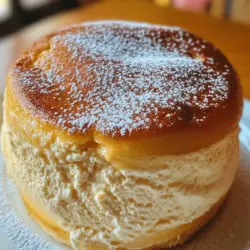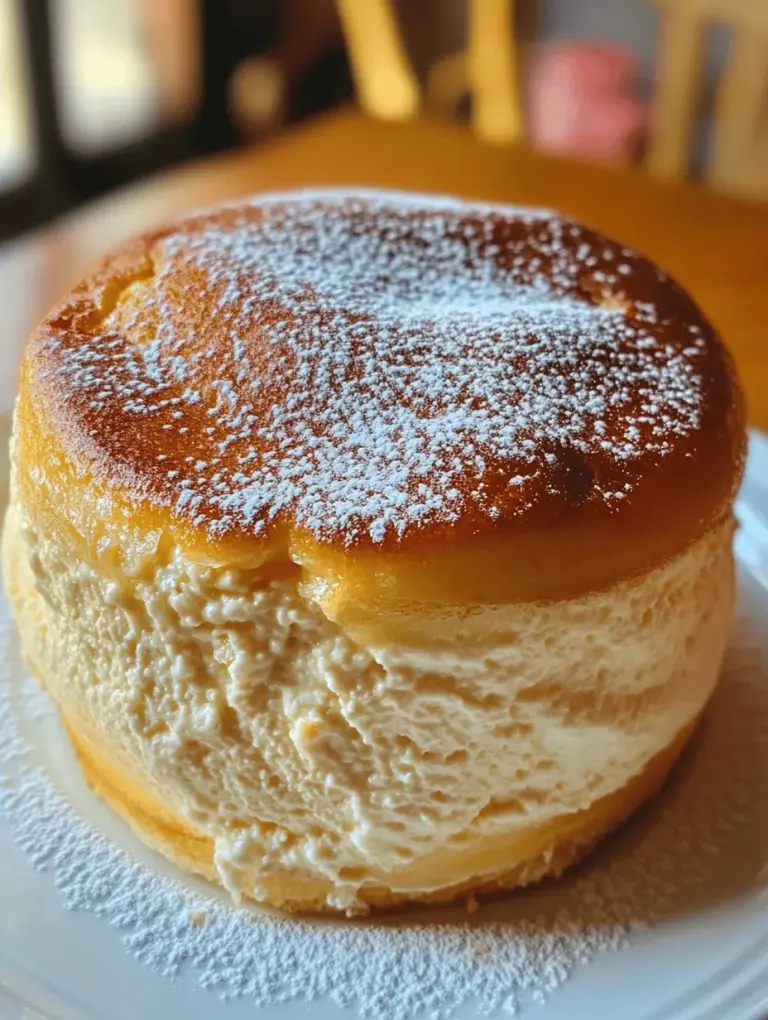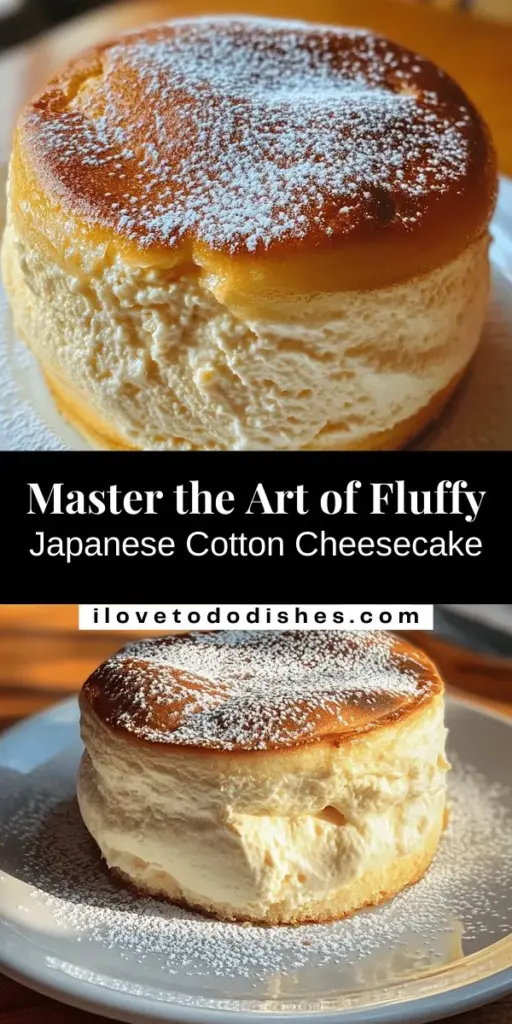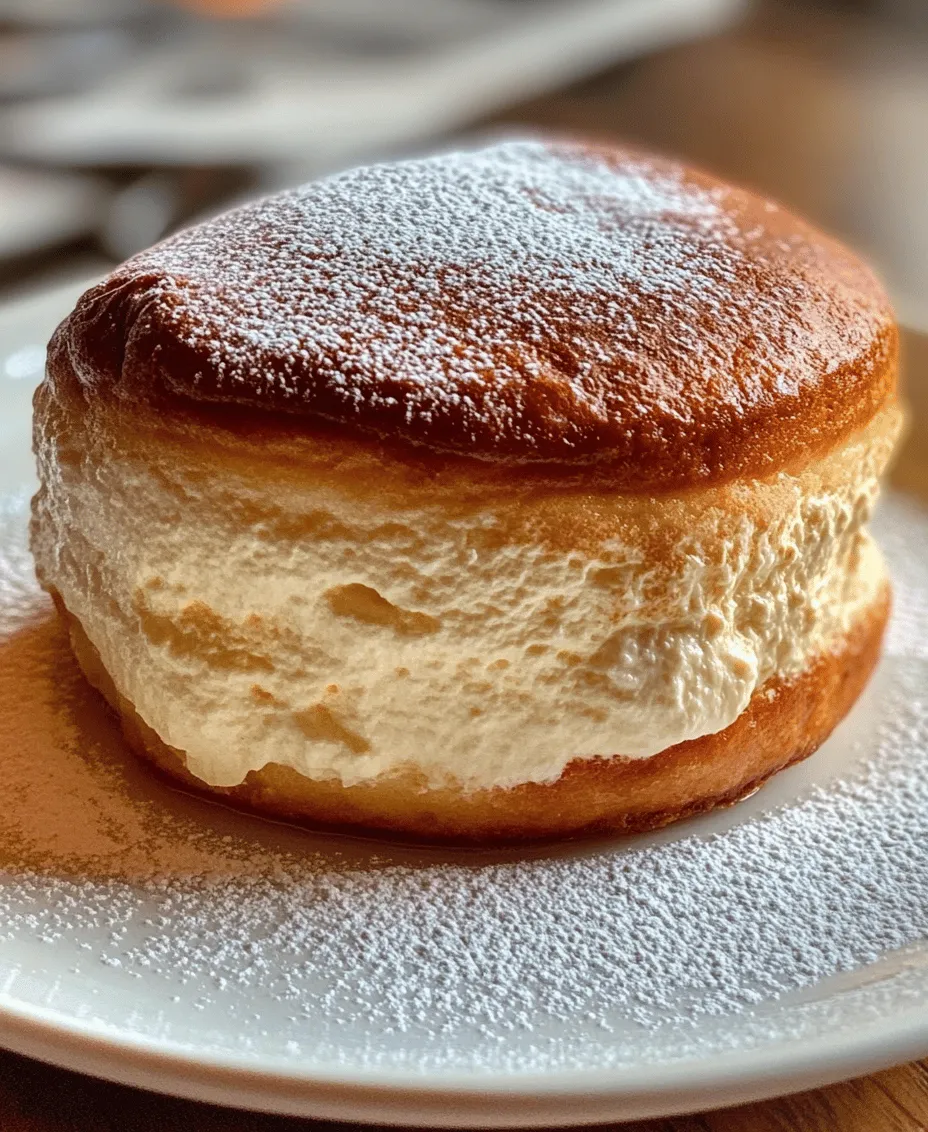Introduction
Understanding the phenomenon of Japanese cotton cheesecake is akin to discovering a delicious secret in the world of desserts. This culinary delight has captured the hearts of dessert enthusiasts around the globe, renowned for its incredibly light and fluffy texture. Unlike traditional cheesecakes, which can be dense and rich, the Japanese version combines the rich creaminess of cream cheese with a unique soufflé-like lightness that makes it a truly irresistible treat. In this article, we will delve into the origins of this delectable dessert, explore the science behind its airy texture, and provide you with a step-by-step guide to making your very own Fluffy Japanese Cotton Cheesecake.
The Allure of Japanese Cotton Cheesecake
Exploring the Origins of Japanese Cheesecake
Japanese cotton cheesecake, also known as “soufflé cheesecake,” has its roots firmly planted in Japan, where it has been delighting palates for decades. The dessert gained popularity in the 1990s and has since become a staple in Japanese bakeries and cafes. While it may seem like a modern invention, the concept of a light and fluffy cheesecake can be traced back to various influences, including Western desserts and traditional Japanese sweets.
Japanese pastry chefs have taken inspiration from Western cheesecakes, adapting the recipe to create a lighter, airier version that aligns with the Japanese culinary aesthetic of simplicity and elegance. The result is a cheesecake that is not only beautiful to look at but also a joy to eat, with a texture that seems to defy gravity.
Understanding its Cultural Significance
In Japanese culture, food is not merely sustenance; it is an art form and a way to express creativity and care. Desserts, in particular, hold a special place in Japanese society, often being presented in a way that emphasizes aesthetics and seasonal ingredients. Japanese cotton cheesecake exemplifies this philosophy perfectly. Its delicate appearance and light texture make it a popular choice for celebrations, family gatherings, and afternoon tea.
Moreover, the rise of social media has amplified the allure of this dessert, with countless food bloggers and influencers sharing their attempts to recreate the fluffy masterpiece. The cheesecake’s unique presentation, often served as a towering soufflé with a golden top and a soft, pillowy body, has made it a visual delight that draws in dessert lovers from all walks of life.
Comparing with Traditional Cheesecakes
Traditional cheesecakes are often rich, dense, and creamy, typically made with a buttery graham cracker crust and a filling that includes cream cheese, sugar, and eggs. While these cheesecakes are undeniably delicious, they can be quite heavy, making them a less appealing choice for those seeking a lighter dessert option.
In contrast, Japanese cotton cheesecake offers a refreshing alternative. Its unique combination of ingredients, including whipped egg whites and a lighter batter, results in a dessert that is fluffy and airy, allowing for a more delicate flavor profile. While traditional cheesecakes can be rich and indulgent, Japanese cotton cheesecake delivers a satisfying sweetness without overwhelming the palate, making it an excellent choice for any occasion.
The Science Behind the Fluffiness
How Egg Whites Affect Texture
The key to achieving the signature fluffiness of Japanese cotton cheesecake lies in the use of egg whites. When whipped, egg whites incorporate air and create a stable foam that provides the structure necessary for the cake’s rise. This process is known as aeration, and it is crucial for achieving the light and airy texture that sets this cheesecake apart from its denser counterparts.
When folded into the cream cheese mixture, the whipped egg whites create a delicate balance. This technique allows the cheesecake to rise beautifully during baking, resulting in a soufflé-like consistency. However, it is essential to handle the egg whites gently to preserve the air bubbles created during whipping. Overmixing can lead to deflation and a denser final product.
The Role of Cream Cheese and Butter
Cream cheese plays a vital role in the flavor and texture of Japanese cotton cheesecake. Its creamy, tangy nature provides the rich base that is characteristic of all cheesecakes. In addition to cream cheese, butter is often included in the recipe to enhance the richness and add a smooth mouthfeel. However, the proportions used in Japanese cotton cheesecake differ from traditional recipes. The emphasis is on achieving a balance between richness and lightness, which is critical for the cake’s overall structure and texture.
Understanding the Importance of Baking Techniques
Baking techniques also play a significant role in the success of Japanese cotton cheesecake. The use of a water bath, or “bain-marie,” is essential for maintaining a consistent temperature while baking. This method helps prevent the cheesecake from overcooking and ensures even heat distribution, resulting in a beautifully tender cake.
Additionally, the baking time and temperature must be closely monitored. Too high of a temperature can lead to a dry, cracked surface, while too low can result in a dense texture. Mastering these techniques is key to achieving the perfect fluffy cheesecake that will impress anyone who has the pleasure of tasting it.
Gathering Your Ingredients
Essential Ingredients for Japanese Cotton Cheesecake
To make a Fluffy Japanese Cotton Cheesecake, you will need the following essential ingredients:
1. Cream Cheese: The star ingredient that provides the rich, creamy base of the cheesecake.
2. Eggs: Both egg yolks and whites are required, with the whites being whipped to create the light texture.
3. Granulated Sugar: Used to sweeten the cheesecake and stabilize the egg whites.
4. Butter: Adds richness and a smooth mouthfeel to the batter.
5. Milk: Helps to create a creamy texture and balances the richness of the cream cheese.
6. Cake Flour: Provides structure while keeping the cheesecake light and fluffy.
7. Lemon Juice: Enhances the flavor and adds a touch of brightness to the cheesecake.
The Importance of Ingredient Quality
When it comes to baking, the quality of your ingredients can significantly impact the final outcome. For Japanese cotton cheesecake, it’s essential to use high-quality cream cheese, preferably full-fat, for a rich flavor and smooth texture. Fresh eggs are also crucial, as they contribute to the airy structure of the cake.
Using high-quality butter and fresh milk will enhance the overall flavor and texture. If possible, opt for organic ingredients, as they tend to offer better taste and quality. In baking, every component matters, so taking the time to select the best ingredients will yield the best results.
Possible Substitutions and Variations
One of the beautiful aspects of Japanese cotton cheesecake is its versatility. While the traditional recipe is delightful, you can easily make substitutions or variations to suit your preferences or dietary needs. For instance, if you are looking for a lower-fat version, consider using reduced-fat cream cheese or Greek yogurt in place of some of the cream cheese.
For those with gluten sensitivities, a gluten-free cake flour can be used instead, allowing everyone to enjoy this delightful dessert. Additionally, flavor variations can be introduced by adding different extracts, such as vanilla, almond, or even matcha powder for a unique twist.
Step-by-Step Instructions for Fluffy Japanese Cotton Cheesecake
Preheating and Preparing Your Baking Pan
Before you start mixing your ingredients, it’s important to preheat your oven to 320°F (160°C). This allows your cheesecake to bake evenly from the start. While the oven is preheating, prepare your baking pan. It is recommended to use a round cake pan, preferably a springform pan for easy removal.
To prevent sticking, line the bottom of the pan with parchment paper and grease the sides with butter. If you are using a springform pan, ensure that it is tightly sealed to prevent any water from leaking in during the baking process. Additionally, you will want to prepare a larger baking dish for the water bath. This will hold the smaller pan and help create a moist environment for baking.
Melting the Cream Cheese Mixture
The first step in your cheesecake-making journey involves creating a smooth cream cheese mixture. In a medium saucepan, combine your cream cheese, butter, and milk. Over low heat, gently melt the mixture, stirring continuously until the cream cheese and butter are fully melted and combined. Be careful not to let the mixture boil, as this can alter the texture.
Once melted, remove the saucepan from heat and allow the mixture to cool slightly. Once cooled, add in the egg yolks, cake flour, and lemon juice. Whisk until the ingredients are fully combined and the batter is smooth. This creamy base is what gives the cheesecake its rich flavor and texture.
As you embark on this culinary adventure, remember that the journey to creating the perfect Fluffy Japanese Cotton Cheesecake is as delightful as the final product itself. The science, technique, and quality ingredients come together to produce a dessert that is not only beautiful but also a joy to eat.
Whisking the Egg Yolks and Combining Ingredients
To start the process of making your Fluffy Japanese Cotton Cheesecake, focus on the egg yolks, which will form the rich, creamy base of the cake. In a large mixing bowl, add the egg yolks along with the granulated sugar. Using a whisk or an electric mixer, beat the yolks and sugar together until the mixture turns pale and slightly thickened. This step is crucial as it incorporates air into the yolks, contributing to the overall fluffiness of the cheesecake.
Next, slowly add the cream cheese to the yolk mixture. It’s best to use cream cheese that’s at room temperature to ensure smooth blending. Mix thoroughly until the cream cheese is fully incorporated and the batter is creamy. Gradually pour in the milk and lemon juice, continuing to whisk until the mixture is smooth and well combined. This combination of ingredients not only enhances the flavor of the cheesecake but also contributes to its moist texture.
Once you have a smooth batter, sift the all-purpose flour and cornstarch over the mixture. Gently fold the dry ingredients into the wet ingredients using a spatula. Be careful not to overmix; the goal is to combine the ingredients without losing the air you’ve incorporated.
Beating Egg Whites to Perfection
The next essential step in creating a light and airy Japanese Cotton Cheesecake is beating the egg whites. In a clean, dry bowl, add the egg whites and a pinch of salt. Start whisking on low speed, gradually increasing to medium until soft peaks form. At this stage, add the cream of tartar, which acts as a stabilizer, helping the egg whites maintain their structure.
Continue beating until the egg whites form stiff peaks. This means that when you lift the whisk, the peaks should stand upright without drooping. It’s important not to overbeat the egg whites, as this can lead to a dry texture. If you accidentally go too far, the mixture will become grainy and hard to fold into the batter.
Gently Folding for Maximum Fluffiness
Once your egg whites are ready, it’s time to incorporate them into the yolk mixture. This step is critical for achieving the signature fluffiness of Japanese Cotton Cheesecake. Start by taking one-third of the beaten egg whites and gently folding it into the yolk mixture. Use a spatula and employ a gentle folding motion—think of lifting and turning the mixture rather than stirring. This technique helps maintain the airiness of the egg whites.
After the first addition, gradually fold in the remaining egg whites in two more batches. The key is to be patient and gentle to avoid deflating the mixture. When the batter is uniform and no visible streaks of egg whites remain, you’re ready for the next step. The batter should be smooth and light, with a fluffy consistency that promises a delightful dessert.
Preparing for the Water Bath
Preparing the water bath is a crucial step in baking your Fluffy Japanese Cotton Cheesecake. This method helps regulate the temperature around the cheesecake, preventing it from baking too quickly and cracking. Start by preheating your oven to 320°F (160°C) and preparing your baking pan.
You will need a 7-inch round cake pan with high sides. To ensure no water leaks into your cheesecake, wrap the outside of the pan with aluminum foil, making sure to cover the bottom and sides completely. This prevents moisture from entering the pan during the baking process.
Place the wrapped cake pan into a larger, deep baking dish. This dish will hold the water bath, so it should be large enough to accommodate the cake pan without difficulty. Once your cake batter is ready, pour it into the prepared pan. Carefully pour hot water into the larger baking dish until it reaches halfway up the sides of the cake pan. This setup creates a humid environment conducive to fluffy, evenly baked cheesecake.
Baking Process: What to Expect
With everything prepared, it’s time to bake your Fluffy Japanese Cotton Cheesecake. Carefully place the baking dish in the preheated oven. Bake for 60-70 minutes, or until the top of the cheesecake is a light golden color and the edges appear set, while the center remains slightly jiggly.
Keep a close eye on the cheesecake during baking, as oven temperatures can vary. If the top begins to brown too quickly, you can cover the cheesecake loosely with aluminum foil to prevent over-browning.
When the baking time is up, turn off the oven and leave the cheesecake inside with the door slightly ajar for an additional 10-15 minutes. This gradual cooling process helps prevent cracks from forming on the surface of the cake as it cools.
Cooling: Why It’s Crucial for Texture
After the cheesecake has cooled in the oven, carefully remove it from the water bath and allow it to cool to room temperature on a wire rack. This step is essential; if you rush the cooling process, the cheesecake may collapse or become dense.
Once it has reached room temperature, cover the cheesecake with plastic wrap and refrigerate for at least 4 hours, preferably overnight. Chilling the cheesecake allows it to set properly, enhancing its texture and making it easier to slice. The waiting time may be challenging, but the reward of a perfectly fluffy cheesecake will be worth it.
Serving Suggestions and Presentation
When you’re ready to serve your Fluffy Japanese Cotton Cheesecake, carefully remove it from the refrigerator. Run a knife around the edges of the pan to help release the cheesecake. Invert the pan onto a serving plate and gently tap the bottom to release the cheesecake. If you’ve used parchment paper, you can easily lift it out.
For presentation, dust the top of the cheesecake with powdered sugar or serve it with fresh fruit, whipped cream, or a drizzle of chocolate sauce. A light fruit compote, such as strawberry or raspberry, pairs beautifully and adds a burst of flavor.
When cutting the cheesecake, use a sharp knife dipped in hot water for clean slices. This ensures that each piece showcases the fluffy, airy texture that is characteristic of a Japanese cotton cheesecake.
Common Mistakes to Avoid
Overbeating Egg Whites
One of the most common mistakes in making Japanese Cotton Cheesecake is overbeating the egg whites. While stiff peaks are essential, overbeating can lead to a dry texture. Stop beating as soon as you see stiff peaks, and remember that it’s better to underbeat slightly than to overbeat.
Not Allowing the Cheesecake to Cool Properly
Rushing the cooling process can compromise the texture. Allow the cheesecake to cool gradually in the oven before transferring it to room temperature. Patience is key in achieving that light, fluffy consistency.
Inadequate Water Bath Preparation
Ensure that your water bath is set up correctly. If water seeps into the cheesecake pan, it can ruin the texture. Wrapping the pan securely in aluminum foil is essential to prevent this mishap.
Ignoring Ingredient Temperatures
Using cold ingredients can hinder the emulsification process. Always ensure that your cream cheese and eggs are at room temperature for optimal blending.
Tips for Perfecting Your Fluffy Japanese Cotton Cheesecake
Adjusting Baking Times for Different Ovens
Oven temperatures can vary widely, so consider using a thermometer to check accuracy. If you know your oven tends to run hot or cold, adjust the baking time accordingly. Keep an eye on the cheesecake as it bakes, and check for doneness by gently shaking the pan.
Experimenting with Flavor Additions
While the classic Japanese Cotton Cheesecake is delicious as is, feel free to experiment with flavor additions. Consider incorporating matcha powder for a green tea twist, or add a splash of vanilla extract for enhanced flavor. You can also fold in lemon zest for a refreshing citrus note.
Storing Leftovers: Best Practices
If you have leftover cheesecake, store it in an airtight container in the refrigerator for up to three days. To maintain its fluffy texture, avoid stacking heavy items on top of it. The cheesecake can also be frozen if wrapped tightly in plastic wrap or aluminum foil; it can last for up to a month. Thaw it in the refrigerator before serving for the best results.
Conclusion
Fluffy Japanese Cotton Cheesecake is more than just a dessert; it’s an experience that combines culinary expertise with the joy of baking. By understanding its origins, the science behind its texture, and following the detailed recipe provided, you can create this delightful treat in your own kitchen. Whether enjoyed as a special occasion dessert or a delightful everyday treat, mastering the Japanese cotton cheesecake will surely impress family and friends alike. With the right techniques and a bit of patience, you’ll be able to warm hearts and satisfy taste buds with this airy, cloud-like cake that captures the essence of comfort and indulgence.



